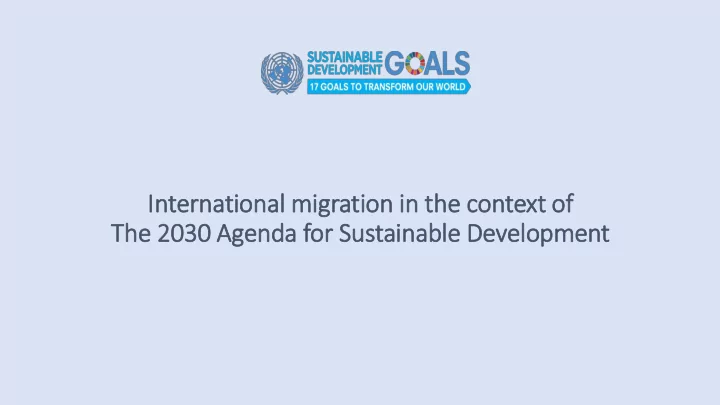

In International mig igration in in th the context xt of The 2030 Agenda for Sustainable Development
Unit ited Natio ions Exp xpert Group Meeting on Im Improvin ing Mig igration Data in in the Context xt of the 2030 Agenda • Objectives : Identify gaps in migration statistics and discuss how to improve the availability and quality • Held in New York from 20 to 22 June 2017 • Organized by UN Statistics Division, In collaboration with UN Population Division and IOM • 50+ experts from • 14 countries • Eurostat, ILO, IOM, OECD, UNESCO, UNFPA, UNHCR, UNICEF, UN-FFDO, UNODC, UN Global Pulse, etc.
Migration in the 2030 Agenda • 11 out of 17 Goals are relevant to migration • 10+ Targets include reference to issues pertaining to migration
SDG Indicators for Global Monitoring 244 indicators * 24 indicators that 1 Contexual require disaggregation by 5 indicators migration status for migrants * include 9 duplicates and 3 triplicates
Why y we care mig igratory ry status in in the context xt of f Agenda 2030? • Combat inequalities within and among countries • Shared prosperity and decent work for all • Pledge that no one will be left behind Indicator 17.18: By 2020, enhance capacity-building support to developing countries, including for least developed countries and small island developing States, to increase significantly the availability of high- quality, timely and reliable data disaggregated by income, gender, age, race, ethnicity, migratory status , disability, geographic location and other characteristics relevant in national contexts Source: Transforming our world: the 2030 Agenda for Sustainable Development, GA resolution, A/RES/70/1
Defin ining mig igratory ry status : : Step-wis ise approach • Step 1: For all indicators that should be disaggregated by migratory status • Country of birth: foreign-born vs native born population • Country of citizenship: foreigners vs citizens • Step 2: If there is a need to distinguish between first generation migrants and second generation migrants, then migratory status could be defined by • Country of birth of the person and country of birth of the parents: foreign-born persons, native-born persons with both parents born abroad and native-born persons with at least one parent born in the country • Step 3: Other disaggregation dimensions: • Age, sex, time of arrival, reason for move….. • Refugees and asylum seekers • Internal migrants • Internally displaced persons (IDPs)
Other recommendations on • Data collection and compilation • P & H Censuses • Surveys • Administrative records • Non-traditional sources • Data dissemination • Methodological development • Coordination • Capacity building
Pla lanned activities • Create an Expert Group on Migration Statistics, comprises of national statistical offices, relevant line ministries and international, regional and sub-regional organizations to enhance coordination and to assist the work on the improvement of migration statistics (2017) • Consult with relevant stakeholders on a standardized questionnaire module to identify international migrants, to be used in censuses and surveys (2017-2018) • Produce a technical publication on collecting, compiling and using data for migration-related SDG indicators (2018) • Provide technical assistance to 6 countries in Asia and Latin America on producing data for migration-related SDG indicators (2018-2021)
Thank you !
Challenges in in defi fining migratory ry status • Balancing between a comprehensive conceptual framework and measurement limitations • Some concepts do not have internationally-agreed definitions • Not all data sources capture information to identify specific groups of migrants • Or not frequent enough – migration is only a special module included in surveys every X number of years • Capturing migrants through household surveys: insufficient sample size • How to work with countries concerned with emigration?
Recommend
More recommend